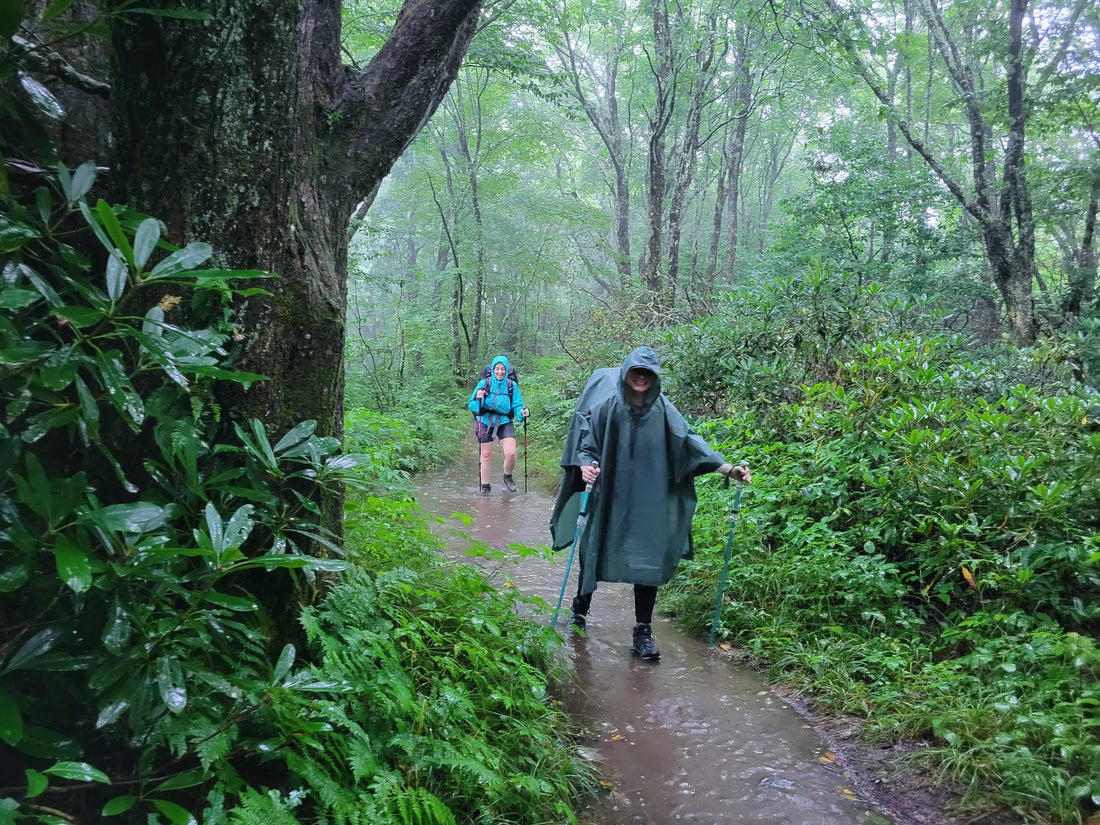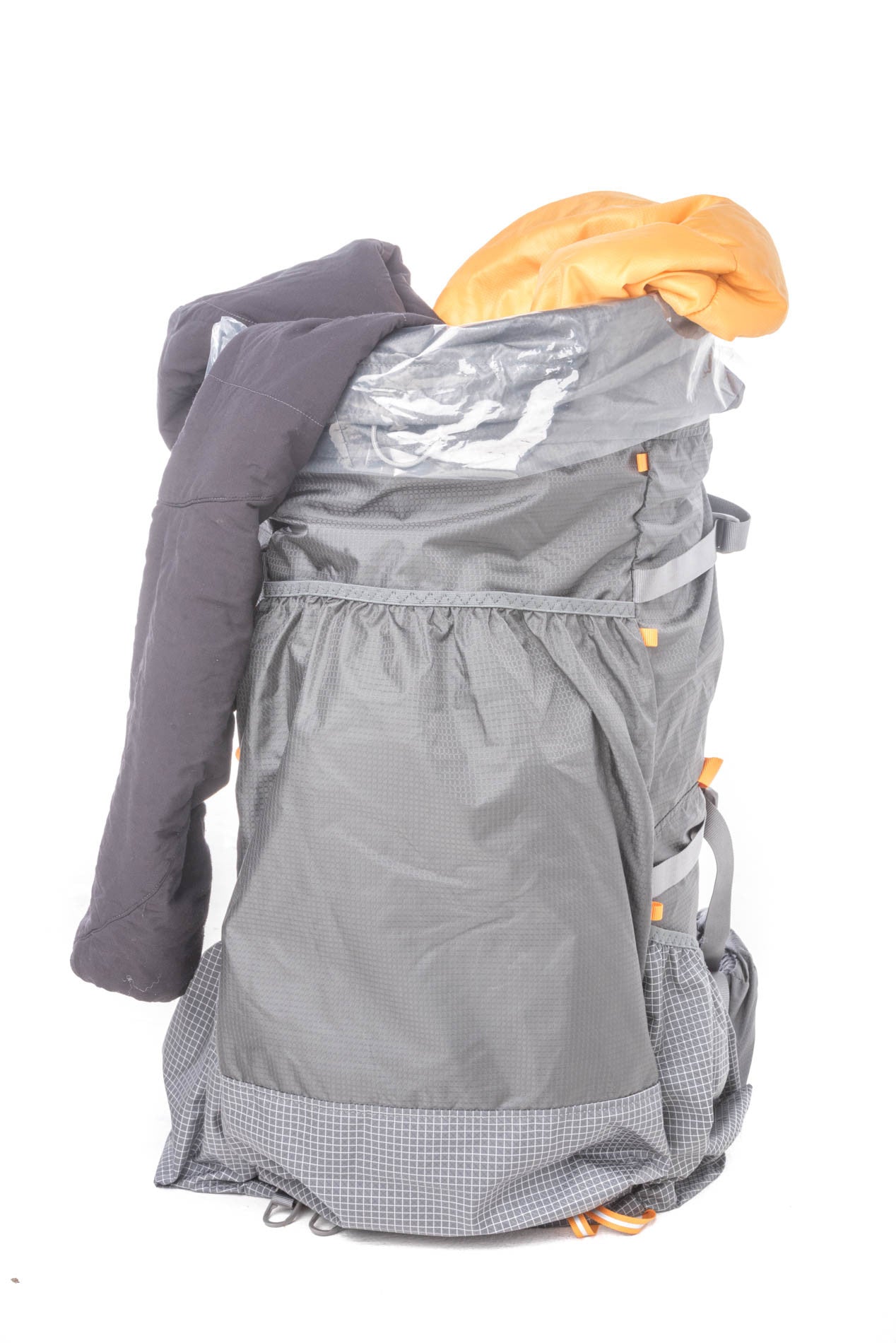
Pack Liners vs. Pack Covers: Which to Use for Backpacking
By Korrin Bishop
Keeping dry. It’s an important yet tricky task while backpacking. There are the inevitable moments where you’re going to have to make your peace with moisture: rainy hiking days, tent condensation, stream crossings, and humidity meets profuse sweating, to name a few.
But even though getting wet is somewhat inevitable during backcountry travel, there are key precautions to take, like ensuring your most critical pieces of gear—sleeping bag, camp clothes, and electronics, for example—remain dry. This is where pack liners and pack covers come in handy.
Do you need both a pack liner and a pack cover for backpacking? Probably not. It’s excess weight and both more or less accomplish the same thing. (Plus, a poncho and pack liner combo offers the true winning option—stay tuned for more on why!)
But, if not both, which one is right for you? We’re here to help you decide!
Below, we’ll give you the full rundown on pack liners and pack covers, including:
- How to Use Pack Liners and Pack Covers
- Pros and Cons of Using a Pack Cover
- Pros and Cons of Using a Pack Liner
- The Verdict: Should You Use a Pack Liner or Pack Cover for Backpacking?
How to Use Pack Liners and Pack Covers
Pack liners are typically plastic bags that are large enough to fill the main compartment of your backpack. They can be trash bags you’d use for your kitchen’s garbage can, or something more fitted for backpacks and made from stronger plastic, such as Gossamer Gear’s clear waterproof pack liners.
Pack liners get inserted into the main compartment of your backpack before you pack all of your gear into it. So, essentially, you’ll be packing your gear into the liner bag. The pack liner creates a waterproof wall between your gear and the outside of your backpack.
Pack covers can be standard plastic bags, but are also commonly made from nylon, polyester, or other fabrics similar to your backpack. They’ll often include elastic around the opening or some sort of cinching device to ensure it fits snugly to your pack.
Pack covers fit over the entire back of your pack whenever you need them. Unless it’s raining out, it’s likely stored in one of your pack’s outer pockets for easy grabbing. Once it starts raining, you take it out, stretch it over your pack’s exterior, and keep hiking. It creates a fairly waterproof shell for your pack.
Pros and Cons of Using a Pack Cover
There are drawbacks and benefits to using a pack cover.
Some of the pros of using a pack cover include:
- Simple to put on. Putting on and taking off pack covers is a pretty quick process. You just need to stretch it over your pack if you need it.
- Keeps the exterior of your pack dry. Since pack covers go on the outside of your bag, they offer water protection to both the gear inside your pack as well as the exterior of your pack.
- Don’t have to remember to put it in first when packing. Since pack covers are a use-as-needed item, you can deploy them whenever, whereas pack liners have to be put into your bag before you pack all of your gear.
Some of the cons of using a pack cover include:
- Dripping water. As water hits your water-resistant pack cover, it beads us and drips down. In many cases, this can mean it drips down onto your behind. If you’re not wearing rain pants, this steady added stream of water can make rainy hiking even more tedious.
- Harder to grab things from side pockets. Once your pack cover is on, you don’t have easy access to the exterior pockets of your pack. So, if you’re trying to reach back for your water bottle, you’ll have some more hurdles to face.
- Can snag on branches. If you have to do any bushwhacking or if you just find yourself on an overgrown trail, pack covers can easily catch on brush as you walk by. This can trip you up, make you lose your cover without realizing it, or even move your pack cover so that it’s no longer fully protecting your gear.
- Potential for leaks. If you don’t fit your pack cover securely around your entire bag, it’s possible for water to get under it still and soak through to your gear.
- Extra weight. Since pack covers need elastic or other closure devices, they often weigh more than pack liners. Additionally, since they’re on the outside of your pack, they collect water weight. If you’re unable to fully dry it out after use, you’ll have to carry it wet in your pack.
- Won’t keep hip belt pockets dry. Pack covers only cover your main compartment, so your hip belt pockets can still get drenched. If they’re not waterproof and you’re keeping your phone in one, beware!
- Have to stop to put it on. To properly deploy your pack cover, you’ll have to take off your pack, which can be a little annoying if you’re trying to move through the rain as quickly as you can.
Pros and Cons of Using a Pack Liner
As with pack covers, there are drawbacks and benefits to using a pack liner.
Some of the pros of using a pack liner include:
- Lightweight. Pack liners are simple: a thin plastic bag. There are no elastic bands or clunky clips that add weight. Also, since it’s on the interior of your pack, it won’t collect water weight and you don’t have to worry about drying it out at camp.
- Cheap. Pack liners are a no frills piece of gear. You can even use a trash bag you already have, though it might not fit quite as nicely as a liner specifically made for backpacking.
- Keeps the bottom of your bag dry and protects gear regardless of the weather. Even when it’s not raining out, your pack liner will come in handy for keeping your gear dry. If you set it down on wet grass, for example, or happen to take a wee tumble into a creek as you’re crossing, the liner is already in place to protect your gear from any water soaking through.
- Creates a nice divider inside your pack. If you end up with a wet tent in the morning or otherwise have gross gear you’d like to separate from your cleaner, dry gear, a pack liner can help with this. Simply slip your wet tent or other gear into the space between the liner and the outside of your pack and place everything else in the liner bag.
Some of the cons of using a pack liner include:
- Have to remember to put them in first when packing. It can be a bit of a pain to have your pack fully loaded and then remember you forgot to put your liner in.
- Using one can take some getting used to. If you haven’t packed your bag with a liner before, it might take a little time to adjust to the feel of it. You still have the same space to work with in your pack, but it may not seem that way at first.
- Might not fit as well with some packs. If you’re using a backpack that has multiple compartments, using a liner might be harder, as it won’t slip as easily into a main compartment.
- Doesn’t keep the outside of your pack dry. While your gear inside your pack will be snug as a bug, you have to remember that the exterior of your pack is still exposed to the elements. So, be mindful of what you’re keeping in your exterior pockets and consider storing items in Ziplocks or other waterproof bags. (There’s another pro tip in the next section, though, that can also help with this!)
 The Verdict: Should You Use a Pack Liner or Pack Cover for Backpacking?
The Verdict: Should You Use a Pack Liner or Pack Cover for Backpacking?
Ultimately, the choice is yours! Do what works best for you and your hike. Our vote, however, goes to the pack liner. When it comes to keeping it lightweight, cheap, and practical, the pack liner truly gets the job done. And, most of its drawbacks have easy fixes.
Here are a couple pro tips to further improve your pack liner experience:
- Having trouble keeping your pack liner in place as you load gear into your bag? Set your pack on the ground and stand it upright as you place the liner into the main compartment. Adjust the liner until it fills up the entire space inside the bag and stand it up parallel with the top of the bag. Next, roll the liner and top of your bag down together three or four times. This keeps your liner in place and offers a wide opening for loading your gear. Once everything is loaded, separate the top of the liner from your pack and roll it down before closing your top lid.
- Worried about keeping gear in your exterior and hip belt pockets dry when using a pack liner? This can be easily solved by choosing a hiking umbrella or poncho as your personal rain attire, both of which will cover the outside of your pack. An umbrella can play double duty keeping you cool on hot days or even offer some reprieve for your doggie. Also, with Gossamer Gear’s hands-free attachment, it can clip right onto your shoulder strap. A poncho is easy to deploy from a side pocket on your pack and covers you and your pack, including hip belt pockets. It can also double as a makeshift tarp if needed and offers greater breathability than many raincoats.
 Hungry for more backpacking gear and planning knowledge? Check out some of our other articles on the Light Feet blog:
Hungry for more backpacking gear and planning knowledge? Check out some of our other articles on the Light Feet blog:
- How To: Tips & Tricks for Alleviating Condensation in Your Tent
- How to Take Care of Your Gear Post-Hike (And Get Motivated to Do It)
- 8 Tips & Tricks for Solo Hiking Trips
- Hydration 101: Your Guide to Water While Hiking
And, if you’re looking for an awesome, lightweight pack liner, you can snag our Clear Waterproof Pack Liners online! They’re sold in two-packs and fit most backpacks, especially those in the Gossamer Gear line. They weigh just 1.2 ounces and are made of super tough 2 mil clear virgin polyethylene film.
Shop the Gear
---
Korrin Bishop is a freelance writer and editor with work published in Sierra, U.S. News & World Report, Southern Living, and Fodor's Travel, among others. Her writing focuses on outdoor adventure, environmental issues, travel, and nonprofits. Learn more about her writing and editing services at korrinbishop.com.
